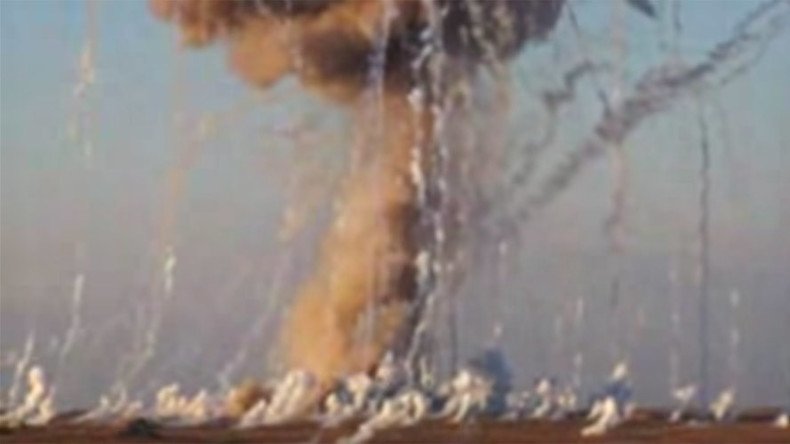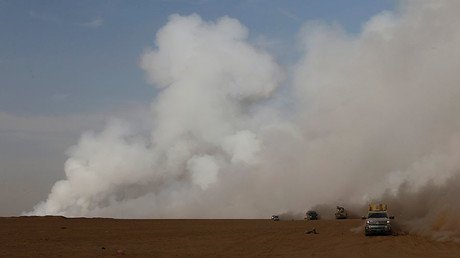White phosphorus used in Mosul siege – Amnesty claims to have evidence

Amnesty International has urged the Iraqi government and US-backed coalition not to use white phosphorus bombs in the vicinity of Mosul, warning of devastating health consequences for civilians who are trying to flee the Islamic State-held city.
The human rights watchdog claimed to have received credible evidence based on photographs and witness testimony which allegedly proves the use of white phosphorus munitions in the village of Karemlesh on October 20, about 20km east of Mosul.
Evidence white phosphorus used in area near Mosul, Iraq posing deadly risk to civilians fleeing the fighting https://t.co/TWuLGbokS0pic.twitter.com/BVROVe91i1
— AmnestyInternational (@AmnestyOnline) 28 October 2016
“White phosphorus can cause horrific injuries, burning deep into the muscle and bone. It is possible that some of it will only partially burn and could then reignite weeks after being deployed,” said Donatella Rovera, senior crisis response adviser at Amnesty International.
While alleging that Assyrian population of Karemlesh had fled the advance of the Islamic State (IS formerly known as ISIS/ISIL) terrorists in August 2014, Amnesty pointed out that during the operation to free Mosul, refugees fleeing towards Erbil will be forced to pass through the contaminated area.
“We are urging Iraqi and coalition forces never to use white phosphorus in the vicinity of civilians. Even if civilians are not present at the time of its use, due to the residual risks they should not use airburst white phosphorus munitions unless it is absolutely necessary to achieve military objectives which cannot be accomplished through safer means,” Rovera said.
Examining photographs taken by a New York Times photographer on October 20 and then interviewing him, Amnesty could not definitively conclude which forces used the white phosphorus munitions.
“It is not clear whether the projectiles were fired by Iraqi central government forces, Peshmerga forces of the Kurdistan Regional Government (KRG), or forces belonging to members of the US-led coalition,” Amnesty said.
But the NGO did conclude based on the photographic evidence that the explosion dispersal pattern “appears consistent with the US-made 155-mm M825A1 projectile, which ejects 116 felt wedges containing white phosphorus over an area between 125 – 250 meters wide.”
The watchdog called on the forces in the area not to use the highly-dangerous weapon or at the very least inform populations about the areas where it was used.
“It is absolutely imperative that the forces using white phosphorus publicize details of areas potentially contaminated by the substance, to minimize the risk of accidental harm to civilians,” said Rovera.
US troops use white phosphorus in Iraq to ‘obscure’ Kurdish forces – newspaper https://t.co/2ISFik6KXgpic.twitter.com/EdVWAD0Auk
— RT (@RT_com) 24 September 2016
Iraqi and Kurdish forces, supported by the US-led international coalition launched an operation to retake Mosul on October 17. The fighting since then displaced an estimated 100,000 people, while up to 1.5 million people remain trapped in Mosul.
Jihadists have taken “tens of thousands” civilians hostage and are herding them towards the city of Mosul to use as human shields, the United Nations warned earlier.
“Credible reports suggest that ISIL has been forcing tens of thousands of people from their homes in sub-districts around Mosul and have forcibly relocated numbers of civilians inside the city itself since the operation began on the 17th of October to restore Iraqi government control over Mosul,” said UN human rights spokeswoman Ravina Shamdasani on Friday.
BREAKING: 60 civilians killed, 200 injured as US-led coalition strikes Mosul residential areas – Russian MoD https://t.co/SJrOWRzxKb
— RT (@RT_com) October 25, 2016
The US-led coalition has dropped more than 2,500 munitions from warplanes, artillery pieces and rocket launchers during the operation, and destroyed 46 tunnels, 33 truck and car bombs and hundreds of other vehicles and fighting positions since the offensive began, according to US Air Force Colonel John Dorrian, spokesman for the US-led Operation Inherent Resolve.
READ MORE: ISIS using ‘tens of thousands’ as human shields in Mosul – UN
US Central Command head General Joseph Votel said this week that nearly 1,000 IS militants have been killed since the operation began. The Pentagon has estimated there are between 3,500 and 5,000 IS fighters in Mosul, and the US military expects the enemy to mount a brutal fight to keep its stronghold.
Meanwhile the Russian military is “closely monitoring” the situation around Mosul, according to General Sergey Rudskoy, head of operations in the Russian General Staff. According to the Defense Ministry, over 60 civilians have been killed and at least 200 injured in the US-led coalition airstrikes on residential areas “residential areas, schools, and other civilian objects both in Mosul and in other parts of the Iraqi Nineveh Governorate.”













